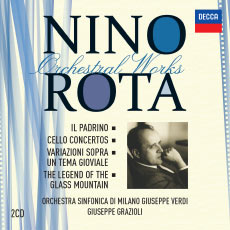How did the idea to publish a complete collection of Nino Rota’s orchestral work come to be? Were you in direct contact with the composer’s right holders in order to complete this mad project?
In 2010/11, in collaboration with the Giuseppe Verdi symphonic orchestra from Milan and its president Luigi Corbani, we scheduled a series of ten concerts to celebrate the 100th anniversary of the composer’s birth. Following their success, we decided to leave a trace of all this work by crafting a first series of three volumes for Decca. Given the interest shown for the release, Decca ordered three new volumes for a total of almost twelve hours of music! The original idea was to prove that cinema wasn’t Nino Rota’s only area of interest. Ever since I started studying and directing his music, several preconceived ideas about him have bothered me: the fact that he was always referred to as “Fellini’s musician”, that his compositions weren’t studied at the conservatory, that he was often accused of only being able to compose “in the style of”, failing to recognise his own style. It’s Francesco Lombardi, a nephew of Nino Rota and writer of the complete catalogue of his works, who provided me with original and unpublished versions of some compositions and who, with Bruno Moretti, Rota’s former student and assistant, helped me recreate some of the film scores that had been “disfigured” by the timing for editing purposes.
Obviously the question of track selection didn’t arise, as it is a complete collection. However, the various works had to be arranged and split over several volumes, and playlists had to be created. How did you proceed?
Unlike other film score composers such as Ennio Morricone or John Williams – who have completely different styles, whether they compose for a concert hall or the big screen – Nino Rota always stayed the same. After a few seconds, you recognise the author, whether you’re listening to his Bassoon Concerto or La Strada original soundtrack. Faced with a composer so genuine and unwilling to establish a hierarchy between musical genres, I thought the most coherent criterion would be… incoherence. Therefore I tried in each volume to mix several areas explored by Rota: film music with symphonic works, chamber music with concertos, stage music or music written for students from the Conservatory of Bari with ballets and opera. I immediately noticed that some melodies designed for a movie kept coming back in a symphony, and then in a ballet or an opera. In fact, in this approach I was guided by an interview of Nino Rota himself, in which he asserted that the composer’s attitude has to be constant, whether they are writing a song for television, variations for a pianist or even a great oratorio. It’s the way the public listens that varies, not the composer’s commitment, which should always be at its maximum.
Create a free account to keep reading



